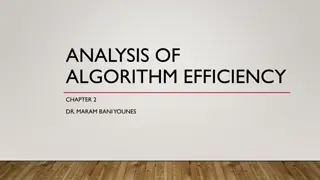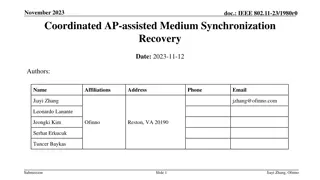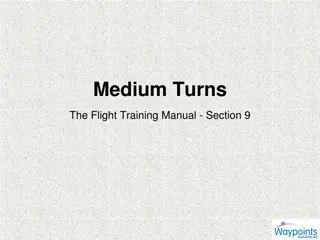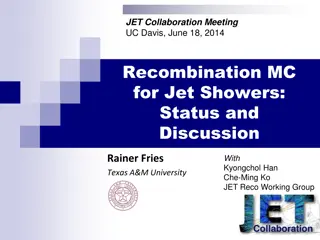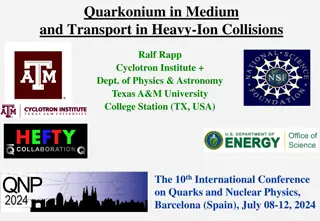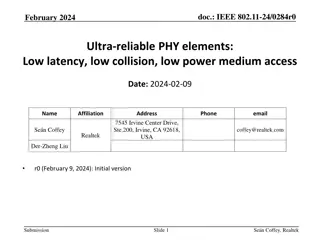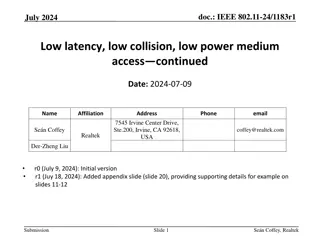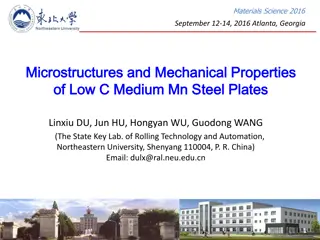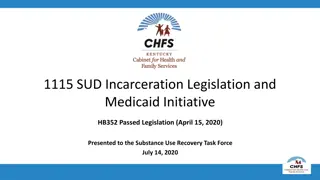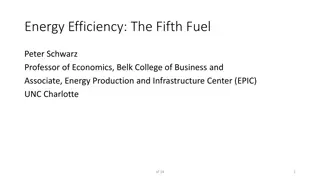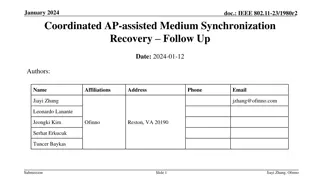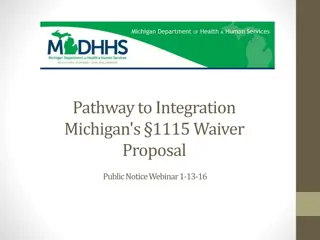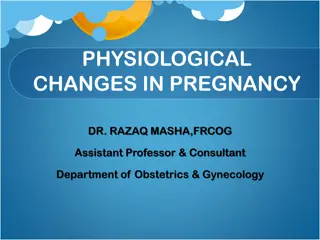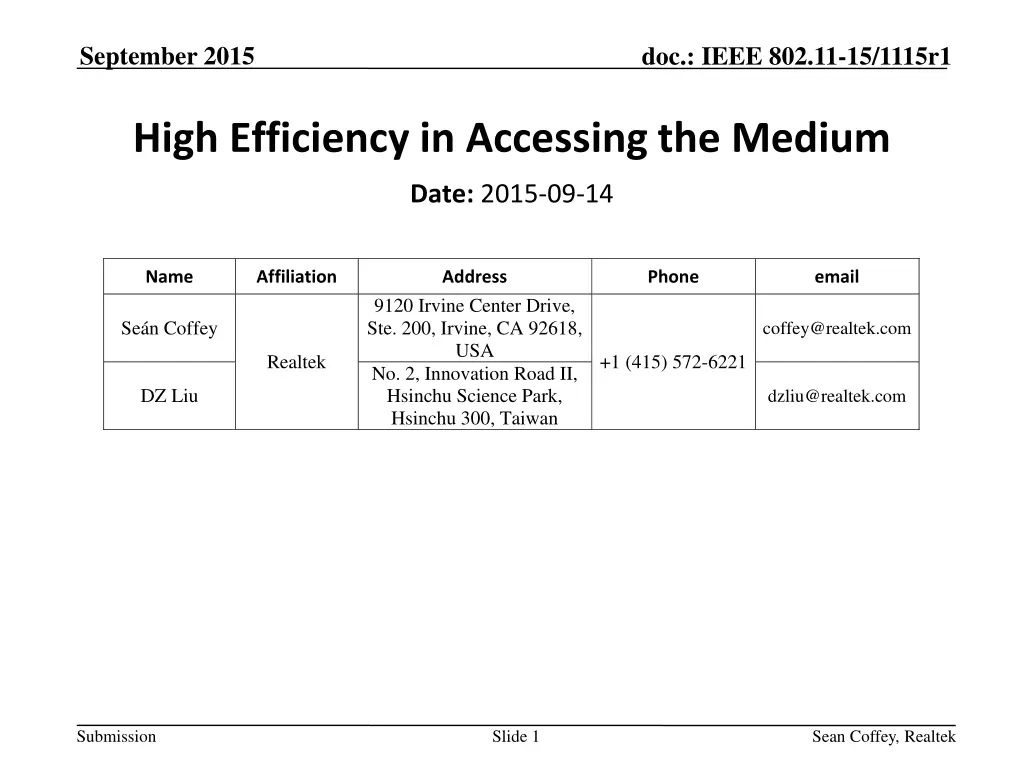
Efficient Medium Access Approach for IEEE 802.11-15 Devices
Explore a novel method to reduce overhead in medium access for IEEE 802.11-15 devices by providing unique backoff slots, ultimately enhancing efficiency. The presentation discusses motivation, baseline comparison, and a detailed approach involving building rosters to allocate backoff slots effectively.
Download Presentation

Please find below an Image/Link to download the presentation.
The content on the website is provided AS IS for your information and personal use only. It may not be sold, licensed, or shared on other websites without obtaining consent from the author. If you encounter any issues during the download, it is possible that the publisher has removed the file from their server.
You are allowed to download the files provided on this website for personal or commercial use, subject to the condition that they are used lawfully. All files are the property of their respective owners.
The content on the website is provided AS IS for your information and personal use only. It may not be sold, licensed, or shared on other websites without obtaining consent from the author.
E N D
Presentation Transcript
September 2015 doc.: IEEE 802.11-15/1115r1 High Efficiency in Accessing the Medium Date: 2015-09-14 Name Affiliation Address Phone email 9120 Irvine Center Drive, Ste. 200, Irvine, CA 92618, USA No. 2, Innovation Road II, Hsinchu Science Park, Hsinchu 300, Taiwan Se n Coffey coffey@realtek.com Realtek +1 (415) 572-6221 DZ Liu dzliu@realtek.com Submission Slide 1 Sean Coffey, Realtek
September 2015 doc.: IEEE 802.11-15/1115r1 Abstract This presentation outlines an approach to reducing medium access overhead, by providing 11ax devices with predictable and unique backoff slots. Submission Slide 2 Sean Coffey, Realtek
September 2015 doc.: IEEE 802.11-15/1115r1 Motivation I Cf. [1] 43 22 AIFS Backoff CCA +IFS . . . 133 15 AIFS Backoff CCA +IFS RTS SIFS CTS SIFS A-MPDU SIFS BA 43 23 20 15 52 15 44 16 356 16 68 Submission Slide 3 Sean Coffey, Realtek
September 2015 doc.: IEEE 802.11-15/1115r1 Motivation Baseline EDCA medium access overhead = the lower of the two quantities shown Both quantities are usually significant [1] It is possible to achieve much lower medium access overhead than either of these, by re-using well-proven components that are already part of the protocol Submission Slide 4 Sean Coffey, Realtek
September 2015 doc.: IEEE 802.11-15/1115r1 Approach Arrange matters so that each STA may obtain a unique backoff slot Two phases: Build a roster Use the roster Submission Slide 5 Sean Coffey, Realtek
September 2015 doc.: IEEE 802.11-15/1115r1 Building a roster* I AP initiates a roster (setup mode): NAV set for legacy devices (say 1 ms) AP * There are many ways to do this STA STA receives CTS Marks its slot as assigned Sends no data Roster initiation: Roster number Roster length Current NAV STA selects random slot within roster length, sends RTS AP marks slot as assigned Doesn t have to note assignee Submission Slide 6 Sean Coffey, Realtek
September 2015 doc.: IEEE 802.11-15/1115r1 Building a roster II AP continues a previously initiated roster (still setup mode): NAV set for legacy devices (say 1 ms) AP STA received no CTS last time (collision) Or couldn t send RTS last time (chosen slot too soon after another device s RTS) Or NAV expired before chosen slot reached STA Roster continuation: Roster number Roster length Current NAV Bitmap of assigned slots Offset within roster length STA selects random unassigned slot within roster length, sends RTS Submission Slide 7 Sean Coffey, Realtek
September 2015 doc.: IEEE 802.11-15/1115r1 Building a roster III AP compresses the roster (still setup mode): NAV set for legacy devices (enough to cover) AP AP: Roster number Bitmap of assigned slots New roster number STAs: Map old nth assigned slot to new slot n Submission Slide 8 Sean Coffey, Realtek
September 2015 doc.: IEEE 802.11-15/1115r1 Using a roster I AP invokes a roster (now in usage mode): NAV set for legacy devices (say 5 ms) AP If the assigned slot is reached within TXOP, STA may transmit Other devices set NAV and freeze countdown as usual Depicted STA will have frozen its own countdown for each preceding transmission by others STA Roster invoked: Roster number Roster length Current NAV Offset within roster length STA / traffic stream uses its assigned slot(s) modulo offset within roster length Submission Slide 9 Sean Coffey, Realtek
September 2015 doc.: IEEE 802.11-15/1115r1 Using a roster II AP invokes a roster (now in usage mode): NAV set for legacy devices (say 5 ms) AP Total loss is limited to one slot time (AP may mark that slot as unused if repeatedly empty) STA Roster invoked: Roster number Roster length Current NAV Offset within roster length STA / traffic stream reaches assigned slot but has no data just don t transmit Submission Slide 10 Sean Coffey, Realtek
September 2015 doc.: IEEE 802.11-15/1115r1 Using a roster III (hidden nodes*) * Non-OBSS for now AP invokes roster with bitmap of protection policy (usage mode): NAV set for legacy devices (say 5 ms) AP STA Roster invoked: all as before Bitmap of slots that are required to use protection Each participating STA reads protection bitmap and allows additional CTS* + SIFS Reads duration from AP s response Submission Slide 11 Sean Coffey, Realtek
September 2015 doc.: IEEE 802.11-15/1115r1 (Diagnosing hidden nodes) One way is to use the roster itself (extra setup step, if needed): NAV set for legacy devices (say 3 ms) AP STA Roster diagnostics: Roster number Roster length Current NAV Bitmap of slots to respond Each participating STA sends response (e.g. NDP) at its assigned turn Each participating STA reports at its assigned turn a bitmap of NDPs it heard Submission Slide 12 Sean Coffey, Realtek
September 2015 doc.: IEEE 802.11-15/1115r1 Example format AP roster initiation / invocation: NAV set for legacy devices (say 1-5 ms) AP CTS-To-Self SIFS RI SIFS Roster initiation: Roster number Roster length Current NAV (Not necessarily at same data rate as CTS-to-self) Submission Slide 13 Sean Coffey, Realtek
September 2015 doc.: IEEE 802.11-15/1115r1 STA processing for new slots I CTS-To-Self SIFS RI SIFS Slot time (if AP bitmap signaled 0) First slot: STA CTS time + SIFS + slot time (if AP bitmap signaled 1) Submission Slide 14 Sean Coffey, Realtek
September 2015 doc.: IEEE 802.11-15/1115r1 STA processing for new slots II A-MPDU / Block Ack VIFS + slot time (if AP bitmap signaled 0) Later slot: (after a busy slot) STA VIFS + CTS time + SIFS + slot time (if AP bitmap signaled 1) VIFS = Vestigial IFS, say 4 s: for CCA, Rx-to-Tx and Tx-to-Rx turnaround times Submission Slide 15 Sean Coffey, Realtek
September 2015 doc.: IEEE 802.11-15/1115r1 Using a roster IV (external hidden nodes) Accounting for external hidden nodes (now in usage mode): NAV set for legacy devices (say 5 ms) AP STAs Each STA does CCA during each VIFS and unused slot Does not use a slot if it falls less than AIFS after any unexpected CCA high CTS-to-self: Mirror the full NAV Sent by first n STAs, n signaled by AP Can be simultaneous; cf. SFD Submission Slide 16 Sean Coffey, Realtek
September 2015 doc.: IEEE 802.11-15/1115r1 Other considerations Unused slots: Appendix A Legacy fairness: Appendix B Fairness and traffic prioritization within roster: Appendix C Roster compared to baseline EDCA: Appendix D Roster compared to PSMP: Appendix E Downlink and multi-user transmissions: Appendix F Numerical example: Appendix G Submission Slide 17 Sean Coffey, Realtek
September 2015 doc.: IEEE 802.11-15/1115r1 Straw poll Do you agree to add the following text to the 11ax SFD? The 11ax specification shall include one or more modes of operation that reduce contention and arbitration overhead, without polling. Yes No Abstain Submission Slide 18 Sean Coffey, Realtek
September 2015 doc.: IEEE 802.11-15/1115r1 References [1] IEEE doc. 11/15-1114r1, Airtime Analysis of EDCA , S. Coffey, D.Z. Liu (Realtek), September 2015 [2] IEEE doc. 11/15-0341r2, Empirical Measurements of Channel Degradation Under Load , C. Lukaszewski, L. Li (Aruba Networks), March 2015 [3] Designing Very High Density Best Practices and Test Results , C. Lukaszewski (Aruba Networks), Wireless LAN Professionals Conference (WLPC) Dallas 2015 Submission Slide 19 Sean Coffey, Realtek
September 2015 doc.: IEEE 802.11-15/1115r1 APPENDIX Submission Slide 20 Sean Coffey, Realtek
September 2015 doc.: IEEE 802.11-15/1115r1 Appendix A: Unused slots Option A: AP marks unused slots as to-be-ignored in a RI bitmap Option B: Slots deemed reassigned to AP if unused n consecutive times AP A: bitmap in RI B: counter in RI May be used to adapt to traffic flow that stops, and to calibrate number of slots needed for a traffic flow that continues Submission Slide 21 Sean Coffey, Realtek
September 2015 doc.: IEEE 802.11-15/1115r1 Appendix B: Legacy fairness Compensate outside the roster Roster devices give up appropriate number of TXOPs after roster AP STA had two TXOPs in data phase . . . so gives up next two after So in principle it is possible to have strict fairness with legacy. More generally the AP may adjust policy to calibrate advantage of HE devices. Submission Slide 22 Sean Coffey, Realtek
September 2015 doc.: IEEE 802.11-15/1115r1 Appendix C: Fairness and traffic prioritization within roster Roster provides guaranteed slots rather than probabilistic advantage AP may grant higher priority traffic more slots AP is free to accept or reject requests to be added to any given roster, and/or maintain multiple rosters for different purposes Roster for mini-TXOPs (e.g., max 200 s) Roster reserved for high-priority traffic AP may commence new roster usage phase at any offset May for example begin new roster usage phase where previous usage of that roster ended So rosters may be used in a way that preserves relative assignments Submission Slide 23 Sean Coffey, Realtek
September 2015 doc.: IEEE 802.11-15/1115r1 Appendix D: Roster compared to baseline EDCA EDCA in which all STAs happen to choose different backoff slots: AIFS A-MPDU SIFS BA No losses due to collisions; a best case Roster: No collisions; but now no need for AIFS, or for RTS/CTS; (group the BAs?) Submission Slide 24 Sean Coffey, Realtek
September 2015 doc.: IEEE 802.11-15/1115r1 Appendix E: Roster compared to PSMP An AP may transmit a recovery frame (called a PSMP recovery frame) during a PSMP-UTT when both of the following conditions are met: The CS mechanism ( ) indicates that the medium is idle at the TxPIFS slot boundary ( ) after the start of the PSMP-UTT, and The PSMP-UTT duration is longer than the total duration of the PSMP recovery frame plus PIFS REVmc D3.0, Section 9.29.2.3, P 1386 LL 11-16 Roster allows all participating devices to infer release of the possible TXOP from one idle slot time, without further frames: lower (and minimal) overhead A STA that has frames to send that are valid for transmission within the PSMP-UTT shall start transmission without performing CCA and regardless of NAV at the start of its PSMP- UTT REVmc D3.0, Section 9.29.2.3, P 1385 LL 55-57 Roster devices perform CCA Submission Slide 25 Sean Coffey, Realtek
September 2015 doc.: IEEE 802.11-15/1115r1 Appendix F: Downlink and multi-user transmissions Downlink transmissions may be added to any roster The AP needs only assign to itself the appropriate slots Marking the slots as assigned in roster initiation frames is enough MU-MIMO transmissions (DL or UL) may also be added to any roster With UL MU-MIMO, an inferred release of the allocated time if uplink transmission does not commence soon after the trigger frame Modified (shorter) trigger frames could be used as position within roster is sufficient to identify STAs Submission Slide 26 Sean Coffey, Realtek
September 2015 doc.: IEEE 802.11-15/1115r1 Appendix G: Numerical example 24 competing STAs, all BE, no hidden nodes At any given time 12 of the STAs will have traffic to transmit which 12 varies constantly A-MPDUs are all 400 s, including preambles AP chooses to limit roster durations to 4 ms EDCA: access overhead 43 + 25 + 121 + 12 = 201 s per successful Tx Roster: Approx. (44 + 16 + 52+ 16) / 8 = 16 s invocation, amortized over successful Tx s < 10 s setup, amortized over reuses < 13 s from unused slots (VIFS + slot time) < 10 s from terminating the roster (60-70 s / 8) = 49 s 75 % reduction 28% throughput improvement The assumptions were conservative and greater % gains can easily be derived Submission Slide 27 Sean Coffey, Realtek



